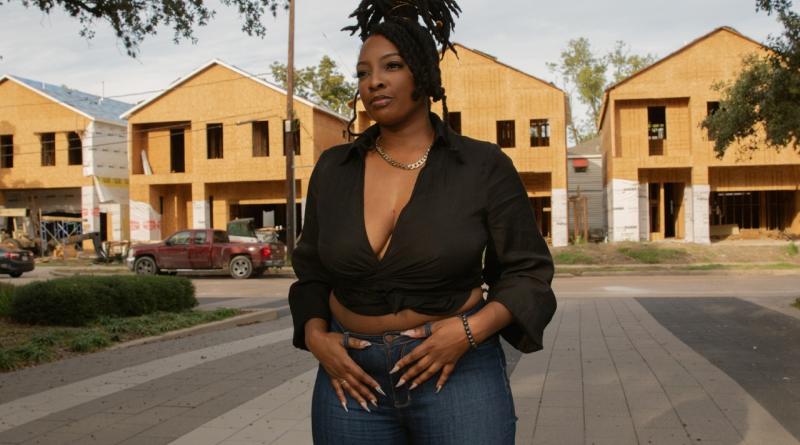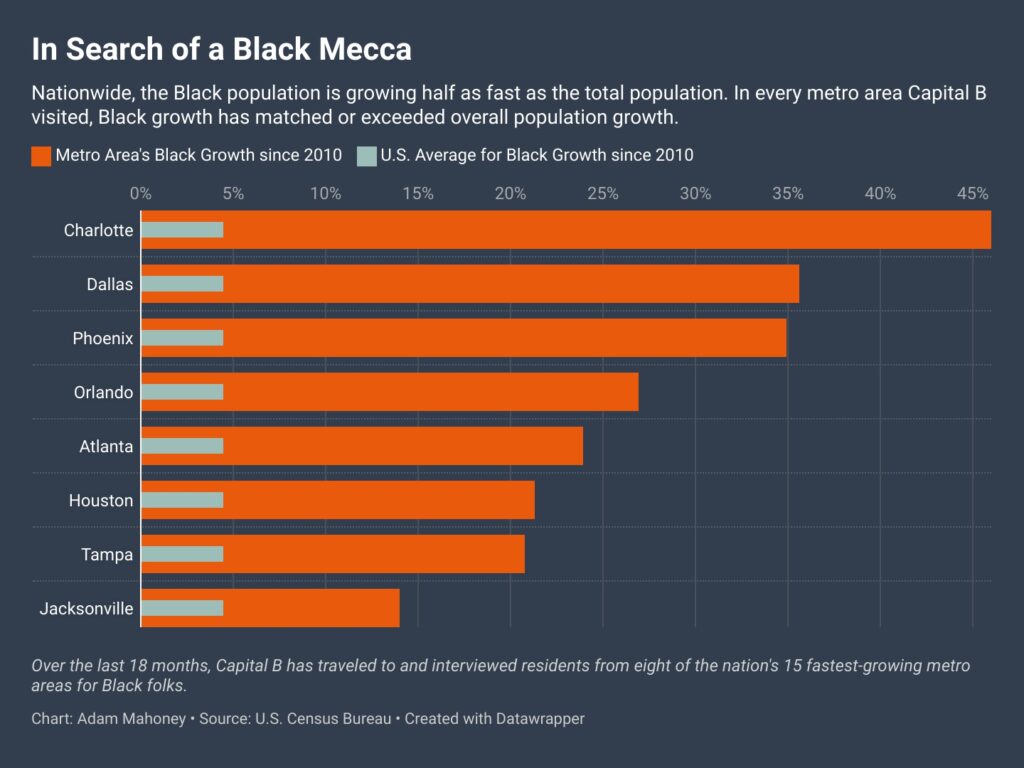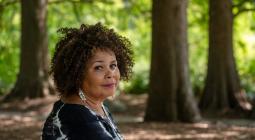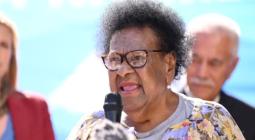Moving South, Black Americans Are Weathering Climate Change

This story was originally published by Capital B. Please sign up for Capital B’s newsletter, which comes out each week, to follow similar stories.
Stephanie Roberson wasn’t expecting this phone call from her husband, Corey.
“I can’t do this anymore,” she remembers him saying. Do what? Her mind went racing.
He was stuck on a mountain over 400 miles away from his family in Cincinnati, his big rig trapped in nearly 3 feet of snow that had blanketed parts of Virginia during that January 2016 storm.
He was tired. Roberson was exhausted by it all, too — the ice-slicked roads and power lines freezing until they snapped like twigs. Not to mention the threat of death: 55 people perished in that snowstorm.
It was one of the moments that solidified her desire to leave Ohio. “I had always wanted to get up and go,” she recalls.
Initially, her mind went to Atlanta or Charlotte, North Carolina, two of the 10 fastest-growing cities for Black folks. But she kept returning to the same dream: waking up on a random weekend to the sun’s hugging warmth and ending it with the softened gold hues of a beach sunset. So, in 2019, after a few years of saving and meandering through the job transfer process, the Robersons and their 10-year-old daughter found themselves in Florida looking for a new home.
Over the past decade, Texas and Florida, two states known for hurricanes and extreme heat waves – but mild winters – have seen the most new residents as roughly a third of relocating Americans say “better weather” is the reason for their moves. The South has reaped these benefits: By 2030, the region is expected to be America’s most populated for the first time.

The trend underscores two decades of transformation dubbed the “Reverse Migration,” where the descendants of Black migrants who moved to the North and Midwest between 1915 and 1970 are moving back to the South, the only region with more Black people migrating in than out since 2000.
For Black folks, this presents a unique set of considerations — and challenges. It seems that in the attempt to escape the environmental racism and the poor health outcomes of the North and Midwest, Black people are essentially moving toward the epicenter of climate disasters, says Rhiana Gunn-Wright, the director of climate policy at the Roosevelt Institute.
The Robersons, for example, left a community exposed to more toxic chemical air pollution than 92% of U.S. neighborhoods for a community outside of Orlando, Florida, where residents, on average, spend more money because of climate disasters than 90% of the nation’s neighborhoods.
Across the South, Black people die during severe weather at higher rates than every ethnic group except Indigenous people. And those who survive are saddled with more debt than other races.
Still, despite two-thirds of Black Americans viewing climate change as a severe issue, floods and sweltering heat seem to fall down the list of considerations for new Southerners, according to two dozen interviews conducted by Capital B. A recent study found that prospective homebuyers in the South are the least concerned with climate risks of all the U.S. regions.
Money talks, especially in the South. “All you hear is that it is cheaper here. That’s why people move here,” Roberson says. “Would you rather rent a three-bedroom or own it?”
But Capital B found as Black people search for an accepting home within the U.S., the threat of climate and environmental injustices touches on all facets of life, making housing less attainable and government policies less favorable.
In just the three years since the Robersons moved to Florida, deadly Hurricane Ian swept through; a disaster-squeezed housing market has contributed to the state’s cost of living increasing the most nationwide; and dozens of laws have been passed that threaten the safety of Black folks.
Yet Roberson has an understanding of this country that’s ingrained in Black folks as children: The far-reaching tentacles of racism are everywhere. And, she says, her family is resilient as long as they have each other — another universal truth for Black America.
For that reason, Sharon Austin, a University of Florida political science professor, says Black Americans should continue to plant their roots in new places. Especially, she says, if they’re investing in building community support networks that help people survive natural disasters and support shifts in cultural and political priorities.
“Anti-Blackness shouldn’t discourage people from moving to Southern states,” says Austin, who moved from the Midwest to Florida in the early 2000s. “And the reason is, we’ve never gotten anywhere by being afraid to fight the system.”
It’s a “defiant act,” she says, that has no intention of stopping: The South accounts for 94% of the nation’s Black population growth since 2020.
In the Name of Growth
Though strong now, Roberson’s faith in her decision to move South has wavered at times. Like when she sat in the dark for two days as Hurricane Ian, the third-costliest weather disaster ever in the U.S., turned Orlando’s streets into swimming pools.
She chose Orlando — instead of Tampa or Jacksonville, Florida’s other growing hubs for Black folks — because she “didn’t want to be in the direct path of hurricanes.” Hurricane Ian missed the memo, leaving the family’s new home with wind damage. A week after the storm hit, she uploaded a 15-minute monologue to YouTube titled “Don’t Move To Orlando After Hurricane Ian.”
“After [Ian], I will always fear that if a hurricane really comes through here, I could lose everything,” she says.
There’s a lot of truth behind that fear. Even when Black residents receive recovery aid, white people who receive the same amount of federal assistance see their wealth rise, while Black residents see their wealth decline following disaster, a study by Rice University found.
Across the region, a string of infrastructure failures and disaster-induced power outages serve as a through line for growing climate and environmental threats, from the hurricanes that flood water purification plants and knock down electrical poles to the intensifying winters that spotlight unreliable electric grids and the fossil fuel pollution created to keep them running. Since 2016, over half of the nation’s largest weather disaster-caused power outages have impacted Southern states. And without electricity, people die.
For Tiara Dawson, a new Houston resident from Detroit, the darkness that settled over the city like a cloud during the deadly winter storm of 2021 led to a personal awakening.
For generations, Southerners survived disasters by leaning on their communities. Along the Gulf Coast, formerly enslaved communities shared food and holed up together away from the swamps and wetlands that absorbed the worst of a hurricane’s blow. But as American isolation increased, communal network systems faltered.
Hundreds of people died in that 2021 storm, but roughly one-third of those deaths came indirectly from carbon monoxide poisoning and doing things like using charcoal grills to heat homes.
“It made me realize that no one has found the survival instincts or tactics to make it through most disasters because many have never experienced them,” Dawson says.
It doesn’t help that the infrastructure needed to survive disasters — alerts and transportation systems, shelters, and levees — constantly fails. And for new residents who typically lack family or large friend groups, a lack of infrastructure makes it harder to survive. Dawson says she could make it for days without water and electricity only by the grace of a new friend whose apartment was spared from the storm.
As a result of slavery and the region’s long dependence on cash crops, the South lagged behind the North in developing urban centers and the infrastructure needed to maintain them. Today, just three of the 16 Southern states have infrastructure — roads, public transportation, sewage and drinking water systems, and electricity, telephone, and internet access — that functions at or above national averages.
But in the rat race for major Southern cities to upgrade their infrastructure, these growing states are seemingly made even more ripe for disaster from the poor urban planning of new neighborhoods, increased pollution, and the razing of the region’s protectors from severe weather: tree canopy and wetlands.
Across the region, new cookie-cutter homes pop up daily at the expense of ecosystems like marshes that once acted as natural defenses against climate disasters. More than 1.3 million acres of land have been razed and paved over across the Southeast since 1985 with little regard for its climate benefits.
“We’re focused on the growth of businesses, subdivisions, and other properties,” says Robert Bullard, the “father” of the environmental justice movement. “When it comes to civil rights, environmental rights, and equal protection, that commitment is not there.”
After Hurricane Harvey pelted Houston and its suburbs in 2017, for example, 20% of new homes were built in a flood plain.
In Florida, Roberson has already seen the impact. “Every block you go to, there is a new community being built,” she says, “but you don’t see anything for the residents already here or anything that would make the growth sustainable.”
The “Bittersweet” Reality of Housing a New Black South
Growing up in Detroit, Willie Davis saw for-sale — and often foreclosure signs — decorate his community’s streets as his classmates, friends, and their families fled South to cities in Georgia and Florida. As a Realtor, he began to understand why: the employment opportunities, relatively affordable housing, and investment in Black entrepreneurship.
“Atlanta and, even more generally, the Southeast,” he says, “looks good on Black people.”
So, in 2021, he and his wife made the jump. Since then, he’s split time working between Atlanta and Detroit, helping other families make similar leaps.
But there, he’s seen how the influx of new residents has transformed the region’s housing market. Private investors have swooped in, as homes rarely last a week on the market. All the while, more Black people find themselves unhoused.
For the larger Black community, wide-ranging reactions have followed.
If there’s a new homeowner in a community, it doesn’t matter if they’re Black, says Qulia Brunson, a real estate broker in Charlotte. “If you’re not from there, Black folks are going to look at you sideways because you’re still seen as a gentrifier — someone trying to change their community.”
Davis and Brunson say this typically results from newer Black homeowners being more wealthy than long-standing Black residents. Still, homeownership opportunities for both new and old Black residents have declined due to Wall Street investors.
Since 2020, investors have targeted low and middle-income Black neighborhoods across the South, slightly outbidding those relying on mortgages by providing cash, according to a New York Times investigation.
Investors know these cities are growing, so they snatch up homes for cheap, and then rent them out, Brunson says. This boxes out homeownership opportunities while jacking up rental prices.
Of the 10 metro areas where investors buy the most homes, three are majority-Black cities, and the rest are in the top 10 fastest-growing metro areas for Black people, including Atlanta, Charlotte, Phoenix, and Orlando.
In Roberson’s small suburb of Orlando, home prices have more than doubled since 2015. And across the state, homeowners’ insurance costs have ballooned to more than 3.5 times the national average. At least a dozen insurance companies have left the state since 2022, threatening to withhold disaster payouts for residents.
Renters don’t fare any better. When disasters strike, renters are left hanging as they’re ineligible for most supportive funding options and find themselves at the mercy of their landlords, who have historically used fires and floods to evict.
But so far, these sticky situations have not slowed migration.
It’s “bittersweet,” Brunson says. “I’m glad that so many Black people are moving here every day, but on the other hand, it is sad to see a lot of people get pushed out of home.”
Revolutionizing the Region—Again
The South’s growing Black population, and especially the activism of Black women, is revolutionizing politics, says Austin, the author of Political Black Girl Magic.
Historically, Black voters, a small but steady minority, are the tipping point in elections, and people of color across the region have already reaped positive political benefits. Until this year, Jacksonville, one of the nation’s most segregated cities, was the largest U.S. city with a Republican leader, but a Black surge in population helped change that.
But on the flip side, Austin argues, this political transformation has jump-started a right-wing shift at state-level legislatures across the South and a gerrymandering process that has limited Black voting power in the Carolinas, Texas, and Florida — and made Black people more vulnerable to climate change.
Republican governors have also pushed agendas that downplay climate threats and reversed climate policies meant to protect people of color.
The limiting of Black representation has particular climate implications because it leaves “a majority of Black residents who are vulnerable to climate change not being represented on it,” says Monique Harden, director of law and public policy at the Deep South Center for Environmental Justice.
If there is a Congress that is majority-white, she believes, that means a Congress less likely to fight for much-needed funding for climate adaptation and recovery in Black neighborhoods. Nationwide, white people are 20% less likely to care about climate change compared to Black people.
It’s retaliation for Black people building new communities, but it’s nothing that Black Americans haven’t already survived, Austin says. During the racist Reconstruction and Civil Rights Era, Black people were targeted and forced to migrate North.
Now, she says, Black people should return and influence the region to support Black life — socially, politically, and environmentally. “Black people have the chance to make the South the standard of American life.”
Even if the Confederate flags and breath-sucking Southern humidity feel suffocating, you have to fight for the life you want and deserve, Roberson says.
“Racism is everywhere; disasters can happen anywhere,” she says. “A lot of people in my family was like, ‘Florida is racist,’ but I’m like, ‘Ohio is racist, too.’”
“This is going to be a challenge anywhere.”





